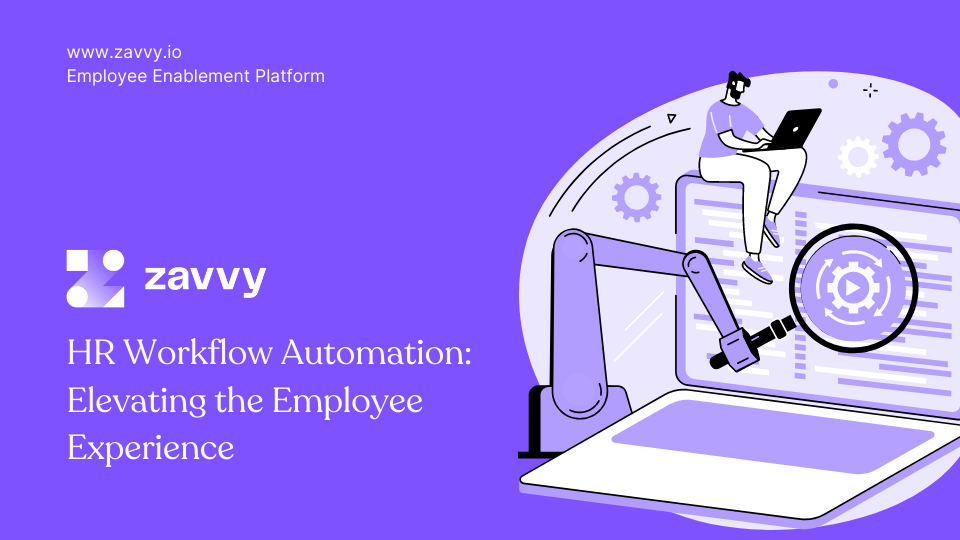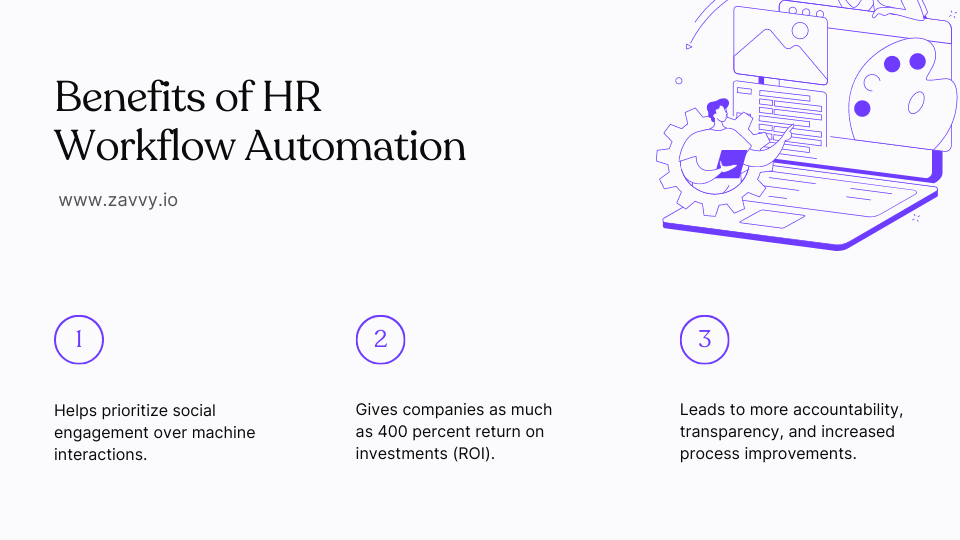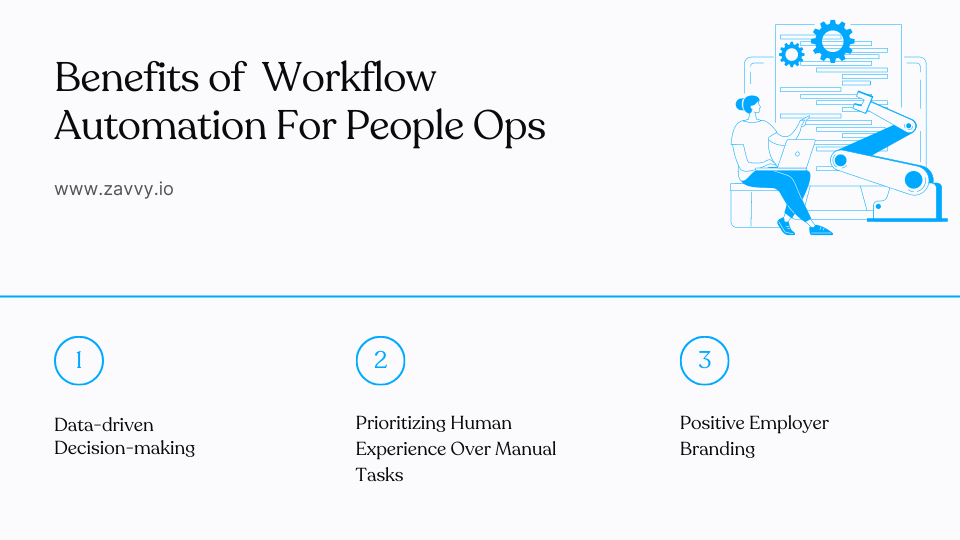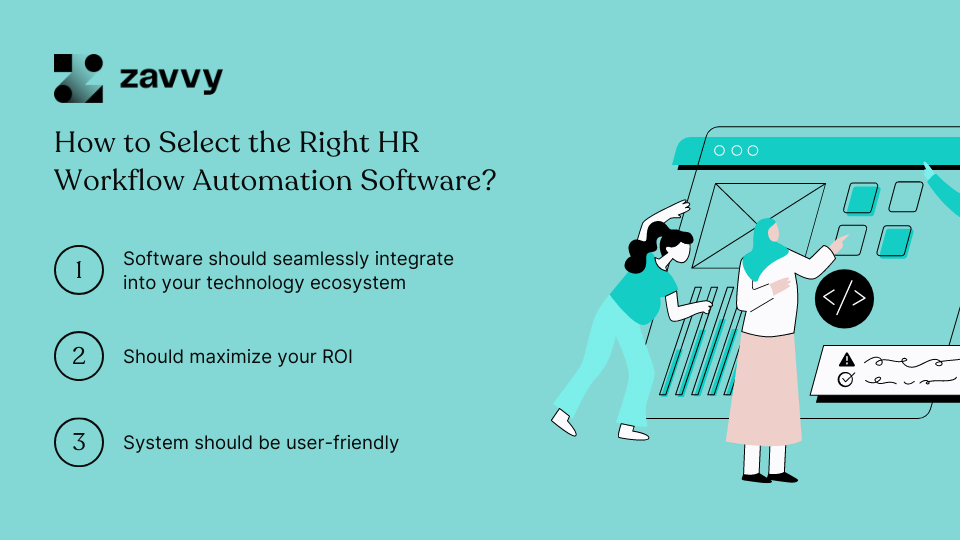
Alexander Heinle
Alex is a marketer at Zavvy. On this blog, he mainly shares insights gained from discussions with selected experts and from helping our customers set up and improve their onboarding or learning programs.


Monotonous, repetitive tasks have long made people feel like they're nothing but cogs in a machine. Advances in AI and machine learning are allowing companies to streamline their workflows and processes in a quest for continuous improvement. Firms now realize that by automating most workflows, employees can finally start to make long-lasting contributions to the business' success. Thus, HR workflow automation is more than just a buzzword making the rounds of some professional circles. In fact, automation and the "future of work" are intimately related concepts.
In a post-pandemic environment where people have re-evaluated how they want to live and work, it is now crucial for companies to make employees feel valued and engaged. A recent survey by consultancy firm McKinsey found out that up to 55 percent of employees value non-financial recognition over outright salary increases.
Thus, businesses should not strive to exclusively enhance their systems but the entire employee experience. You can enable your employees to perform their roles better through automated HR workflows that are more relevant, engaging, and empowering.
Together with our curators, we have created a library of actionable digital marketing resources. Personalized to your team's needs.
HR automation comprises delegating common processes and tasks to software. Some of the common examples include:
The huge developments within HR automation have facilitated remote and hybrid work. The benefits of freeing employees and HR professionals to do high-value work with minimal errors have led to the expansion of the human resources technology market. Research firm Statista predicts the industry to grow from USD 47.5 billion in 2019 to USD 90 billion by 2025.
A workflow is a series of detailed tasks necessary to complete a process or an output. They are often repetitive and high-volume. Moreover, depending on the department or line of work, they tend to have minimal updates.
Pro Tip: Because of their predictability and structured nature, workflows are ideal for automation.
Most people think workflow automation refers only to low-value tasks, but it can also apply to corporate strategy and management.
When workflows are automated, the software tool of choice follows procedures using rules-based algorithms, which allow for everyday tasks to be programmed. Some examples of tasks are: copying and pasting, filling out forms, and sending messages to specific emails. Because these workflows are now standardized, they have nearly zero percent error rates unless there are infrastructure breakdowns or cyber-attacks.
Our article on 30 HR Automation Statistics To Know in 2022 lists multiple benefits of HR automation. But what about HR workflow automation, in particular?

The advantages of HR workflow automation can go beyond merely crossing out tasks for the day and moving on to the next list. Workflow automation can improve overall employee experience and corporate gains.
Workflow automation in HR usually comprises standard processes that affect nearly all employees. The most crucial are onboarding, manager training, and employee development.
The first few months of integrating into a company are essential and can be nerve-wracking for the new employee. According to a study by software provider BambooHR, as much as 17 percent of employees leave within the first six months, particularly among entry-level workers. When asked about their "first-week wishlist," employees mentioned on-the-job training, company policies review, equipment setup, and mentorship.
What these preferences indicate is that employees want to have clear guidelines on what they should do next. In addition, they want a friendly face, not a completely autonomous HR system. The best way companies can achieve this is to build a holistic employee onboarding workflow that will make employees feel welcomed, confident, and integrated into the company culture.
An automated onboarding workflow can look like this:
Being promoted as a new manager can induce a lot of self-doubt and imposter syndrome. The best way that companies can empower their managers is to assign an automated workflow that will give them in-depth guidance to become more confident in their expanded roles.
Additionally, an automated manager training workflow can help established managers stay updated on the latest leadership trends and management systems.
A strong leadership training program ensures that the next generation of managers will act in the spirit of the company's ethos and strategic goals. Leadership training also enables a comprehensive knowledge transfer that is crucial for employees across all levels.
An automated manager training workflow can look like this:
Pro Tip: HR can also incorporate other tasks into the workflow, such as a recurring lunch or dinner event with fellow managers to establish rapport and provide a venue for peer discussions and knowledge exchange.
According to a study by analytics company Gallup, 87 percent of Millennials consider professional development and career growth as the main drivers of their engagement at work. In addition, an overwhelming majority of employees (94 percent) would stay longer if their company invested in upskilling. As a result, many companies now have their own learning management systems, formal mentorship curriculum, and leadership training programs.
Most people see employee development as training, but that's just one component. Employee development is an umbrella program covering the entire career progression within the company. So not only does it encourage loyalty, but it's also a crucial element of succession planning.
An automated annual employee development workflow can look like this:
It's also important to schedule a regular one-to-one feedback or mentorship session to encourage employees and continuously get their feedback, understand their unique challenges, and establish better programs to support them.
People operations is a subset of HR that focuses on employee engagement and productivity. This business function ensures that employees' needs and preferences are considered carefully and integrated into HR programs and systems. This means ensuring that all processes – from recruitment to onboarding to offboarding – are done with the employee's well-being in mind.

Workflow automation can help improve People Ops in three major ways:
There are dozens of automation providers out there, and some have certain specialties. The question to primarily consider is: what does your company need? What is your goal for automating HR workflows? Is it to streamline admin tasks, or is it to automate your training programs?

Here are three additional questions to ask:
With our software solution, you can create customized and interactive workflows like onboarding, training, feedback, and development. Our workflow builder is so flexible that you can create any program, whether automated manager training for new leaders, coffee roulettes for new joiners, or detailed career tracking.
We have templates that can serve as your guide and inspiration as you build your own workflow. Our system can also integrate into your existing tools, such as Slack, Microsoft Teams, and Notion. Should you have any concerns or clarifications, our dedicated customer success managers and support team are on standby to assist you.
We'd love to help you out. Schedule a free demo today.
Upskill your team every week with the best contents and personalized recommendations.

Monotonous, repetitive tasks have long made people feel like they're nothing but cogs in a machine. Advances in AI and machine learning are allowing companies to streamline their workflows and processes in a quest for continuous improvement. Firms now realize that by automating most workflows, employees can finally start to make long-lasting contributions to the business' success. Thus, HR workflow automation is more than just a buzzword making the rounds of some professional circles. In fact, automation and the "future of work" are intimately related concepts.
In a post-pandemic environment where people have re-evaluated how they want to live and work, it is now crucial for companies to make employees feel valued and engaged. A recent survey by consultancy firm McKinsey found out that up to 55 percent of employees value non-financial recognition over outright salary increases.
Thus, businesses should not strive to exclusively enhance their systems but the entire employee experience. You can enable your employees to perform their roles better through automated HR workflows that are more relevant, engaging, and empowering.
Get a demo!
We'll be happy to show you around and answer all your questions.
Trusted by innovative companies



We'll be happy to show you around, answer your questions, or arrange a free trial.
Erhalten Sie eine kostenlose Demo unserer Onboarding-Software.
Vertraut von



Your Training & Development Strategy - Solved in 1 Tool.
Trusted by innovative companies



We'll be happy to show you around, answer your questions, or arrange a free trial.
Learn how Zavvy helps you drive performance, development, and engagement.
Trusted by innovative companies



We'll be happy to show you around, answer your questions, or arrange a free trial.
We'll be happy to show you around and answer all your questions.
Trusted by innovative companies



We'll be happy to show you around, answer your questions, or arrange a free trial.
Gerne zeigen wir Ihnen ganz unverbindlich unsere Plattform im Detail.
Vertraut von modernen Unternehmen



Get a demo!
We'll be happy to show you around and answer all your questions.
Trusted by innovative companies



We'll be happy to show you around, answer your questions, or arrange a free trial.
Erhalten Sie eine kostenlose Demo unserer Software für Mitarbeiterenwicklung und Training.
Moderne Unternehmen
setzen auf Zavvy


